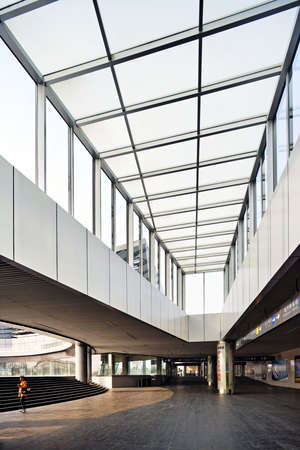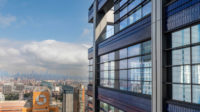
A new high-speed train complex in Bengbu is nearing completion, featuring a pair of mixed-use buildings and a 30,000-square-foot public plaza. Designed by Shanghai-based Verse Design, the two six-story buildings bracket an existing train station, which opened in 2011, and define the north and south sides of the new plaza.

|
|
Photo courtesy Verse Design
A new high-speed train complex in Bengbu is nearing completion. Designed by Shanghai-based Verse Design, the two six-story buildings bracket an existing train station, which opened in 2011, and define the north and south sides of the new plaza.
|
Set seven miles east of the existing city in Anhui Province, the Bengbu South Railway Station and its adjacent buildings are seen by Bengbu officials as a catalyst for a new business district in the area. Trains on the Jinghu High Speed Railway now connect the new transit hub to Beijing 485 miles away and Shanghai 265 miles away with buses and taxis taking people to the center of Bengbu. A light-rail line will connect the high-speed train station to downtown when a second phase of construction is completed in a few years.
Because it sits in an area that had been undeveloped, the project had to create its own urban context. So the architects at Verse designed the two new buildings to frame and activate the plaza, which they also designed. One of their key strategies says Verse design partner Paul Tang, was to create two ground planes: one at the train station's main level and the other 16 feet below. This approach allowed the buildings to split the flow of passengers entering and leaving the station, reducing congestion, especially during peak travel times. It also created a lower plaza for large communal activities and an upper one for people watching and less intense activities.
Shops and restaurants will occupy the first two levels of both buildings, while the north building will have a business hotel on floors three through six and the south building will have offices on those floors. The core and shell of the buildings are done, but the interiors are still under construction.
In addition to giving the complex an urban character, Verse made it a priority to use a number of sustainable-design strategies—incorporating both active and passive technologies. Solar-orientation studies helped shaped the architecture, creating faceted, three-part facades for each building. A total of 18,460 square feet of building-integrated photovoltaics were installed on elevations and roofs and should contribute approximately 25 to 30 percent of the buildings' power, says Tang. An extensive system of geothermal wells should contribute about 80 percent of the energy needed to cool the buildings, adds Tang. The architects also maximized the number of operable windows on upper floors and carved out a large atrium in each building to bring in daylight and pull hot air up and out of the building. Verse worked with China State Construction Engineering Corporation on the curtain-wall design and the Bengbu Institute of Planning Design and Research on construction documents.



Post a comment to this article
Report Abusive Comment